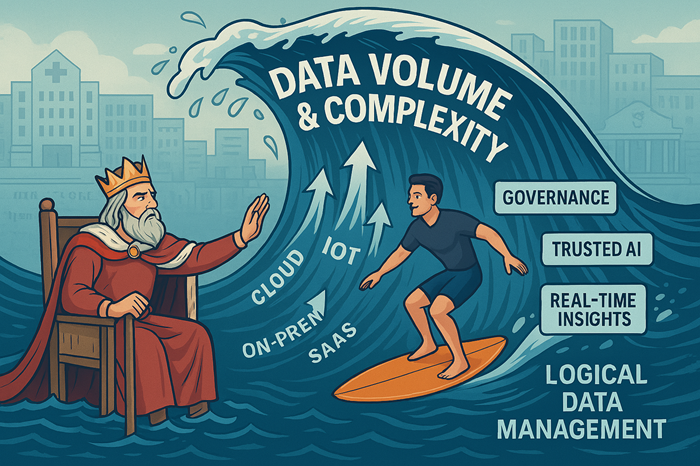
Let’s face it — data isn’t just growing. It’s exploding. Not only are the number of sources increasing, but each source now generates exponentially more data, in more formats, and from more locations — on-prem, SaaS, hybrid cloud, edge devices, partner ecosystems. It’s a level of complexity that demands a smarter approach — and that’s where Logical Data Management becomes essential. The result? A data deluge that traditional approaches simply can’t handle anymore.
Yet, some organizations still believe they can wrestle this wave into submission by centralizing everything into a monolithic data lake or lakehouse. That’s a costly assumption — and an outdated one.
Trying to bring all data into a central location before using it is like King Canute commanding the tide to stop. It won’t.
Trusted AI Needs More Than Storage
We often hear, “AI is only as good as the data it’s trained on.” True. But that doesn’t mean all data needs to be physically moved and stored before it becomes useful. In fact, doing so can delay insight, increase cost, and introduce risk.
The real challenge is not access to data, but trusted, timely, and governed access to the right data. That’s a critical distinction.
Enter Logical Data Management
Logical Data Management (LDM) is a modern approach that enables real-time, governed access to distributed data, without physically moving it.
Instead of centralizing first, LDM connects to data wherever it resides:
- Exposes a unified, governed view
- Applies metadata, policies, and lineage
- Makes data discoverable, AI-ready, and business-ready — instantly
It’s the foundation for:
- Trusted AI insights
- Hyper-personalization
- Holistic compliance
- Operational agility
Stop Asking “Where Is the Data?” — Start Asking “How Can I Use It?”
In a world that demands faster decisions, responsible AI, and increasingly complex compliance, agility is key. LDM flips the script:
- No more waiting months to build pipelines
- No more redundant silos
- No more compromised insights due to stale data
Instead, you get:
Speed — deliver data in real-time
Trust — governed, consistent views
Scale — across clouds, systems, and teams
Flexibility — adapt as your data landscape evolves
Centralization Alone Is Not the Answer
The goal is no longer just “store everything in one place” — it’s use everything in the right way.
Yes, central platforms like data warehouses and lakehouses still have a role. But they must now coexist with a logical layer that bridges across data, systems, and silos.
Because in today’s world, business moves at the speed of data — and data must move at the speed of trust.
Final Thought: Don’t Be Like Canute
King Canute couldn’t stop the tide, and neither can we.
But with Logical Data Management, we don’t need to.
Instead of resisting the rising tide of data, we ride it — safely, swiftly, and with full control.
- Holding Back the Data Tide: Why Logical Data Management is No Longer Optional - April 16, 2025
- AI Can’t Save Lives If Healthcare Data Stays Broken - April 3, 2025
- Developing a Practical, Value-Driven GenAI Strategy for Insurance - March 20, 2025

